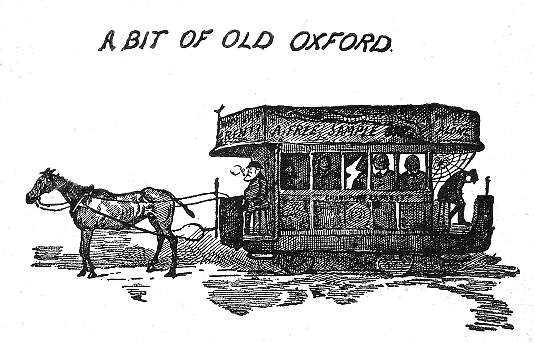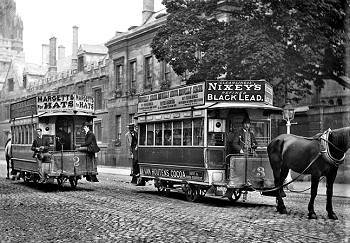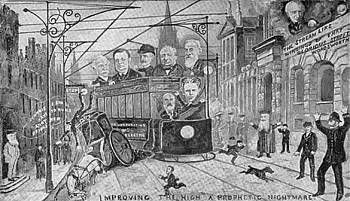

The comedy theme here is the same as that for the York Horse Tramway Postcard. This postcard, with a sketch of a horse tram and the caption "A Bit of Old Oxford", was published by Davis's of 2 Cornmarket, Oxford and was designed and printed in Oxford. Our copy was posted in 1905, but the card dates from around 1903. The smaller postcard view at the bottom of the page is from the same publisher. Produced around 1906 it satirizes the proposals for electrification with the caption "Improving the High, a Prophetic Nightmare", with images of local councillors riding the tram and disturbed Dons looking on.
Exactly like the other university town of Cambridge, which incidentally also had a similar "A Bit of Old Cambridge" postcard, the City of Oxford had a 4 foot gauge horse tramway that closed in 1914 and was never electrified. Started by the Oxford Tramways Co. Ltd., who had obtained operating powers under the Oxford Tramways Order of 1879, this initial company's powers were taken over in 1880 by the City of Oxford & District Tramways Co. Ltd. On 1st December 1881 they opened the first line eastwards from the GWR/LNWR railway stations via Carfax to a terminus in Cowley Road at Magdalen Road, crossing the River Cherwell at Magdalen Bridge, which had to be widened the following year. In 1882 a second route was opened from Carfax via St. Giles to the north along the Banbury Road to Rackham's Lane (now called St. Margaret's Road), extended in 1898 to South Parade, Summertown. In 1884 a route was opened from Carfax to the north-east along Walton Street to Kingston Road. The last completely new route was opened in 1887 from Carfax southwards to New Hinksey via St. Aldates and Abingdon Road, crossing the Thames (or strictly speaking called the Isis in Oxford) at Folly Bridge. In total the tramway was 5¼ miles. The depot and stables were in Leopold Street close to the Cowley Road terminus, with additional stables in Brewer Street off St. Aldates.
 Single deck cars 2 & 3, similar to the drawing on our postcard, are shown left in the High Street (known in Oxford simply as "The High") near Queen's Lane in about 1891, which is a view by the famous Oxfordshire outdoor photographer Henry W. Taunt (1842-1922). Henry Taunt had a shop in Broad Street, Oxford and a floating houseboat studio on the Thames. In 1871 he published "A New Map of the River Thames" as a guide for tourists and boaters, heavily illustrated with his photographs. Many more views of Oxford trams, including more from Henry Taunt, can be seen in our Historic Photos section.
Single deck cars 2 & 3, similar to the drawing on our postcard, are shown left in the High Street (known in Oxford simply as "The High") near Queen's Lane in about 1891, which is a view by the famous Oxfordshire outdoor photographer Henry W. Taunt (1842-1922). Henry Taunt had a shop in Broad Street, Oxford and a floating houseboat studio on the Thames. In 1871 he published "A New Map of the River Thames" as a guide for tourists and boaters, heavily illustrated with his photographs. Many more views of Oxford trams, including more from Henry Taunt, can be seen in our Historic Photos section.
Rolling stock details are not totally certain. The first trams were eight small single-deck one horse cars (some sources say twelve), with longitudinal seating for 20 to 25 passengers, possibly built by the Starbuck Car & Wagon Co. Ltd. of Birkenhead. Next purchased were double-deck trams, probably built by Starbuck, having it is thought transverse seats on the lower deck and knifeboard seats on the upper. The early cars were later augmented or replaced by double-deck trams, some of which were new from Geo. F. Milnes & Co. Ltd of Birkenhead with 20 passengers seated inside probably on longitudinal seats and 26 on top on transverse seats, and others a mixture of second hand from London tramways (North Metropolitan, London Street Tramways, London County Council), bringing the final fleet to a maximum of twenty double-deckers. The livery was dark red and white, with some cars later being described as chocolate brown or golden brown and white or cream, possibly the ex L.C.C. cars still in their old colours. At maximum there were about 150 horses, although a number were used for a horse bus service to supplement the trams.
 With the contract set to expire in 1907, the company sought a 40 year extension by presenting the Corporation an ambitious plan for new routes and electrification using conduit in the city centre and with overhead in the outlying areas. This was rejected by the Corporation, but in 1905 it appointed consultants to look into motor buses and electrification of the tramways. The latter option was preferred but the report advocated the use of the cheaper Dolter surface contact stud system, which in March 1906 the manufacturers demonstrated at the Randolph Hotel by means of a working model. In December 1906 the National Electric Construction Co. Ltd won the tender for operating the tramway for the Corporation on a 42 year contract and set up the City of Oxford Electric Tramways Co. Ltd., which in 1908 took over the horse tramway with an agreement to within five years converting to standard gauge, electrification on the Dolter system and introducing about ten miles of new route. However, the French Dolter system, as used in Mexborough (1907-08), Torquay (1907-11) and Hastings (1907-13), was not proving successful and in 1908 the Corporation rejected its use. The only alternative was conduit but the company was having trouble raising the necessary capital and the Corporation rejected the total use of overhead. In 1911 the company proposed that the Corporation themselves should electrify the lines using conduit, which they swiftly declined. Then in 1912 the company offered to electrify with conduit in a much reduced area of the city centre with overhead in the outlying areas and a reduced rent payable to the Corporation, or a petrol-electric and overhead combination, or overhead throughout, but the Corporation would not agree to any of these options.
With the contract set to expire in 1907, the company sought a 40 year extension by presenting the Corporation an ambitious plan for new routes and electrification using conduit in the city centre and with overhead in the outlying areas. This was rejected by the Corporation, but in 1905 it appointed consultants to look into motor buses and electrification of the tramways. The latter option was preferred but the report advocated the use of the cheaper Dolter surface contact stud system, which in March 1906 the manufacturers demonstrated at the Randolph Hotel by means of a working model. In December 1906 the National Electric Construction Co. Ltd won the tender for operating the tramway for the Corporation on a 42 year contract and set up the City of Oxford Electric Tramways Co. Ltd., which in 1908 took over the horse tramway with an agreement to within five years converting to standard gauge, electrification on the Dolter system and introducing about ten miles of new route. However, the French Dolter system, as used in Mexborough (1907-08), Torquay (1907-11) and Hastings (1907-13), was not proving successful and in 1908 the Corporation rejected its use. The only alternative was conduit but the company was having trouble raising the necessary capital and the Corporation rejected the total use of overhead. In 1911 the company proposed that the Corporation themselves should electrify the lines using conduit, which they swiftly declined. Then in 1912 the company offered to electrify with conduit in a much reduced area of the city centre with overhead in the outlying areas and a reduced rent payable to the Corporation, or a petrol-electric and overhead combination, or overhead throughout, but the Corporation would not agree to any of these options.
In 1913 William R. Morris (later Lord Nuffield) of Morris Motors started the Oxford Motor Bus Company running Daimler motor buses in competition to the trams, so the tramway company soon began their own bus services using similar buses as a solution to its aging tramway problem, and in 1914 Morris sold his buses to the tramway company. On 27th January 1914 the Walton Street and New Hinksey tram routes ceased and finally, after a steady decline, the last horse trams ran in Oxford sometime around 7th August 1914, at which date the Oxford & District Tramways Act (1914) received Royal Assent granting the legal powers for abandonment. In 1921 the tramway company changed its name to City of Oxford Motor Services Ltd., which is still the legal operator's name of the "Oxford Bus Company", now part of the Go-Ahead Group. Funny to think that in the end the City of Oxford Electric Tramways Company only ever operated horse trams and motor buses!
![]() Go to Postcard Of The Month Index
Go to Postcard Of The Month Index